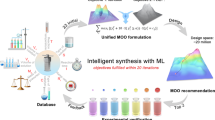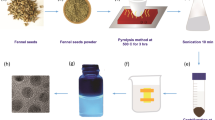Abstract
Carbon dots (CDs) have wide application potentials in optoelectronic devices, biology, medicine, chemical sensors, and quantum techniques due to their excellent fluorescent properties. However, synthesis of CDs with controllable spectrum is challenging because of the diversity of the CD components and structures. In this report, machine learning (ML) algorithms were applied to help the synthesis of CDs with predictable photoluminescence (PL) under the excitation wavelengths of 365 and 532 nm. The combination of precursors was used as the variable. The PL peaks of the strongest intensity (λs) and the longest wavelength (λl) were used as target functions. Among six investigated ML models, the random forest (RF) model showed outstanding performance in the prediction of the PL peaks.

Similar content being viewed by others
References
Efros, A. L.; Brus, L. E. Nanocrystal quantum dots: From discovery to modern development. ACS Nano 2021, 15, 6192–6210.
Wang, G.; Ji, J. W.; Zhang, X. W.; Zhang, Y.; Wang, Q. B.; You, X. Z.; Xu, X. X. Colloidal nanocrystals fluoresced by surface coordination complexes. Sci. Rep. 2014, 4, 5480.
Xu, X. X.; Ji, J. W.; Wang, G.; You, X. Z. Exciton coupling of surface complexes on a nanocrystal surface. Chemphyschem 2014, 15, 2536–2541.
Hinterding, S. O. M.; Salzmann, B. B. V.; Vonk, S. J. W.; Vanmaekelbergh, D.; Weckhuysen, B. M.; Hutter, E. M.; Rabouw, F. T. Single trap states in single CdSe nanoplatelets. ACS Nano 2021, 15, 7216–7225.
Pietryga, J. M.; Park, Y. S.; Lim, J.; Fidler, A. F.; Bae, W. K.; Brovelli, S.; Klimov, V. I. Spectroscopic and device aspects of nanocrystal quantum dots. Chem. Rev. 2016, 116, 10513–10622.
Kagan, C. R.; Bassett, L. C.; Murray, C. B.; Thompson, S. M. Colloidal quantum dots as platforms for quantum information science. Chem. Rev. 2021, 121, 3186–3233.
Xu, G. X.; Zeng, S. W.; Zhang, B. T.; Swihart, M. T.; Yong, K. T.; Prasad, P. N. New generation cadmium-free quantum dots for biophotonics and nanomedicine. Chem. Rev. 2016, 116, 12234–12327.
Lan, M. H.; Zhao, S. J.; Zhang, Z. Y.; Yan, L.; Guo, L.; Niu, G. L.; Zhang, J. F.; Zhao, J. F.; Zhang, H. Y.; Wang, P. F. et al. Two-photon-excited near-infrared emissive carbon dots as multifunctional agents for fluorescence imaging and photothermal therapy. Nano Res. 2017, 10, 3113–3123.
Zhu, P. D.; Wang, S. Y.; Zhang, Y. Q.; Li, Y. F.; Liu, Y. P.; Li, W. J.; Wang, Y. Y.; Yan, X.; Luo, D. X. Carbon dots in biomedicine: A review. ACS Appl. Bio Mater. 2022, 5, 2031–2045.
Jiang, Z. Y.; Guan, L. N.; Xu, X. J.; Wang, E. R.; Wang, C. L. Applications of carbon dots in electrochemical energy storage. ACS Appl. Electron. Mater. 2022, 4, 5144–5164.
Chung, Y. J.; Kim, J.; Park, C. B. Photonic carbon dots as an emerging nanoagent for biomedical and healthcare applications. ACS Nano 2020, 14, 6470–6497.
Anwar, S.; Ding, H. Z.; Xu, M. S.; Hu, X. L.; Li, Z. Z.; Wang, J. M.; Liu, L.; Jiang, L.; Wang, D.; Dong, C. et al. Recent advances in synthesis, optical properties, and biomedical applications of carbon dots. ACS Appl. Bio Mater. 2019, 2, 2317–2338.
Zhang, M. R.; Su, R. G.; Zhong, J.; Fei, L.; Cai, W.; Guan, Q. W.; Li, W. J.; Li, N.; Chen, Y. S.; Cai, L. L. et al. Red/orange dual-emissive carbon dots for pH sensing and cell imaging. Nano Res. 2019, 12, 815–821.
Sinha, S.; Kim, P. H.; Switzer, C. 2’, 5’-Linked DNA is a template for polymerase-directed DNA synthesis. J. Am. Chem. Soc. 2004, 126, 40–41.
Brumbaugh, J.; Schleifenbaum, A.; Gasch, A.; Sattler, M.; Schultz, C. A dual parameter FRET probe for measuring PKC and PKA activity in living cells. J. Am. Chem. Soc. 2006, 128, 24–25.
Zhu, S. J.; Song, Y. B.; Zhao, X. H.; Shao, J. R.; Zhang, J. H.; Yang, B. The photoluminescence mechanism in carbon dots (graphene quantum dots, carbon nanodots, and polymer dots): Current state and future perspective. Nano Res. 2015, 8, 355–381.
Hassan, M.; Gomes, V. G.; Dehghani, A.; Ardekani, S. M. Engineering carbon quantum dots for photomediated theranostics. Nano Res. 2018, 11, 1–41.
Ji, Z. H.; Zhang, L. L.; Tang, D. M.; Chen, C. M.; Nordling, T. E. M.; Zhang, Z. D.; Ren, C. L.; Da, B.; Li, X.; Guo, S. Y. et al. High-throughput screening and machine learning for the efficient growth of high-quality single-wall carbon nanotubes. Nano Res. 2021, 14, 4610–4615.
Thakkar, A.; Johansson, S.; Jorner, K.; Buttar, D.; Reymond, J. L.; Engkvist, O. Artificial intelligence and automation in computer aided synthesis planning. React. Chem. Eng. 2021, 6, 27–51.
Kamakura, Y.; Chinapang, P.; Masaoka, S.; Saeki, A.; Ogasawara, K.; Nishitani, S. R.; Yoshikawa, H.; Katayama, T.; Tamai, N.; Sugimoto, K. et al. Semiconductive nature of lead-based metal-organic frameworks with three-dimensionally extended sulfur secondary building units. J. Am. Chem. Soc. 2020, 142, 27–32.
Talapatra, A.; Uberuaga, B. P.; Stanek, C. R.; Pilania, G. A machine learning approach for the prediction of formability and thermodynamic stability of single and double perovskite oxides. Chem. Mater. 2021, 33, 845–858.
Lu, S. H.; Zhou, Q. H.; Ma, L.; Guo, Y.; Wang, J. L. Rapid discovery of ferroelectric photovoltaic perovskites and material descriptors via machine learning. Small Methods 2019, 3, 1900360.
Gladkikh, V.; Kim, D. Y.; Hajibabaei, A.; Jana, A.; Myung, C. W.; Kim, K. S. Machine learning for predicting the band gaps of ABX3 perovskites from elemental properties. J. Phys. Chem. C 2020, 124, 8905–8918.
Chen, H. A.; Tang, P. H.; Chen, G. J.; Chang, C. C.; Pao, C. W. Microstructure maps of complex perovskite materials from extensive Monte Carlo sampling using machine learning enabled energy model. J. Phys. Chem. Lett. 2021, 12, 3591–3599.
Voznyy, O.; Levina, L.; Fan, J. Z.; Askerka, M.; Jain, A.; Choi, M. J.; Ouellette, O.; Todorovic, P.; Sagar, L. K.; Sargent, E. H. Machine learning accelerates discovery of optimal colloidal quantum dot synthesis. ACS Nano 2019, 13, 11122–11128.
Chen, G. Y.; Zhu, X.; **ng, C. Y.; Wang, Y. K.; Xu, X. X.; Bao, J. C.; Huang, J. H.; Zhao, Y. R.; Wang, X.; Zhou, X. Q. et al. Machine learning-assisted microfluidic synthesis of perovskite quantum dots. Adv. Photonics Res. 2023, 4, 2200230.
Muyassiroh, D. A. M.; Permatasari, F. A.; Iskandar, F. Machine learning-driven advanced development of carbon-based luminescent nanomaterials. J. Mater. Chem. C 2022, 10, 17431–17450.
Wang, X.; Wang, B.; Wang, H. S.; Zhang, T. Y.; Qi, H. H.; Wu, Z. Y.; Ma, Y. R.; Huang, H.; Shao, M. W.; Liu, Y. et al. Carbon-dot-based white-light-emitting diodes with adjustable correlated color temperature guided by machine learning. Angew. Chem., Int. Ed. 2021, 60, 12585–12590.
Luo, J. B.; Chen, J.; Liu, H.; Huang, C. Z.; Zhou, J. High-efficiency synthesis of red carbon dots using machine learning. Chem. Commun. 2022, 58, 9014–9017.
Senanayake, R. D.; Yao, X. X.; Froehlich, C. E.; Cahill, M. S.; Sheldon, T. R.; McIntire, M.; Haynes, C. L.; Hernandez, R. Machine learning-assisted carbon dot synthesis: Prediction of emission color and wavelength. J. Chem. Inf. Model. 2022, 62, 5918–5928.
Wang, X. Y.; Chen, B. B.; Zhang, J.; Zhou, Z. R.; Lv, J.; Geng, X. P.; Qian, R. C. Exploiting deep learning for predictable carbon dot design. Chem. Commun. 2021, 57, 532–535.
Hong, Q.; Wang, X. Y.; Gao, Y. T.; Lv, J.; Chen, B. B.; Li, D. W.; Qian, R. C. Customized carbon dots with predictable optical properties synthesized at room temperature guided by machine learning. Chem. Mater. 2022, 34, 998–1009.
Chen, J.; Luo, J. B.; Hu, M. Y.; Zhou, J.; Huang, C. Z.; Liu, H. Controlled synthesis of multicolor carbon dots assisted by machine learning. Adv. Funct. Mater. 2023, 33, 2210095.
Han, Y.; Tang, B. J.; Wang, L.; Bao, H.; Lu, Y. H.; Guan, C. T.; Zhang, L.; Le, M. Y.; Liu, Z.; Wu, M. H. Machine-learning-driven synthesis of carbon dots with enhanced quantum yields. ACS Nano 2020, 14, 14761–14768.
Weiss, C. J. A creative commons textbook for teaching scientific computing to chemistry students with python and jupyter notebooks. J. Chem. Educ. 2021, 98, 489–494.
Lafuente, D.; Cohen, B.; Fiorini, G.; García, A. A.; Bringas, M.; Morzan, E.; Onna, D. A gentle introduction to machine learning for chemists: An undergraduate workshop using python notebooks for visualization, data processing, analysis, and modeling. J. Chem. Educ. 2021, 98, 2892–2898.
Mombrú, D.; Romero, M.; Faccio, R.; Mombrú, Á. W. Electronic structure of edge-modified graphene quantum dots interacting with polyaniline: Vibrational and optical properties. J. Phys. Chem. C 2017, 121, 16576–16583.
Wang, L.; Li, W. T.; Yin, L. Q.; Liu, Y. J.; Guo, H. Z.; Lai, J. W.; Han, Y.; Li, G.; Li, M.; Zhang, J. H. et al. Full-color fluorescent carbon quantum dots. Sci. Adv. 2020, 6, eabb6772.
Tepliakov, N. V.; Kundelev, E. V.; Khavlyuk, P. D.; **ong, Y.; Leonov, M. Y.; Zhu, W. R.; Baranov, A. V.; Fedorov, A. V.; Rogach, A. L.; Rukhlenko, I. D. sp2-sp3-Hybridized atomic domains determine optical features of carbon dots. ACS Nano 2019, 13, 10737–10744.
Semenok, D. V.; Zhou, D.; Kvashnin, A. G.; Huang, X. L.; Galasso, M.; Kruglov, I. A.; Ivanova, A. G.; Gavriliuk, A. G.; Chen, W. H.; Tkachenko, N. V. et al. Novel strongly correlated europium superhydrides. J. Phys. Chem. Lett. 2021, 12, 32–40.
Righetto, M.; Privitera, A.; Fortunati, I.; Mosconi, D.; Zerbetto, M.; Curri, M. L.; Corricelli, M.; Moretto, A.; Agnoli, S.; Franco, L. et al. Spectroscopic insights into carbon dot systems. J. Phys. Chem. Lett. 2017, 8, 2236–2242.
Acknowledgements
This work was supported by the National Natural Science Foundation of China (No. 22175095).
Author information
Authors and Affiliations
Corresponding authors
Electronic Supplementary Material
Rights and permissions
About this article
Cite this article
**ng, C., Chen, G., Zhu, X. et al. Synthesis of carbon dots with predictable photoluminescence by the aid of machine learning. Nano Res. 17, 1984–1989 (2024). https://doi.org/10.1007/s12274-023-5893-6
Received:
Revised:
Accepted:
Published:
Issue Date:
DOI: https://doi.org/10.1007/s12274-023-5893-6




